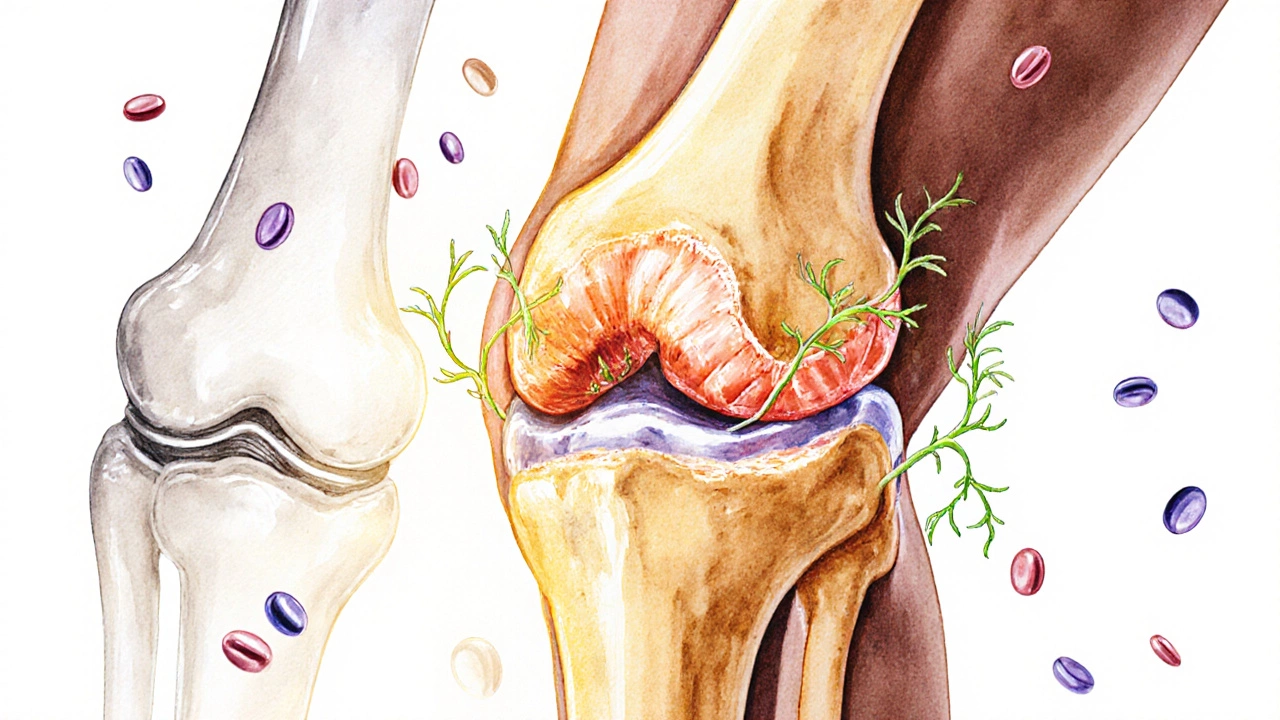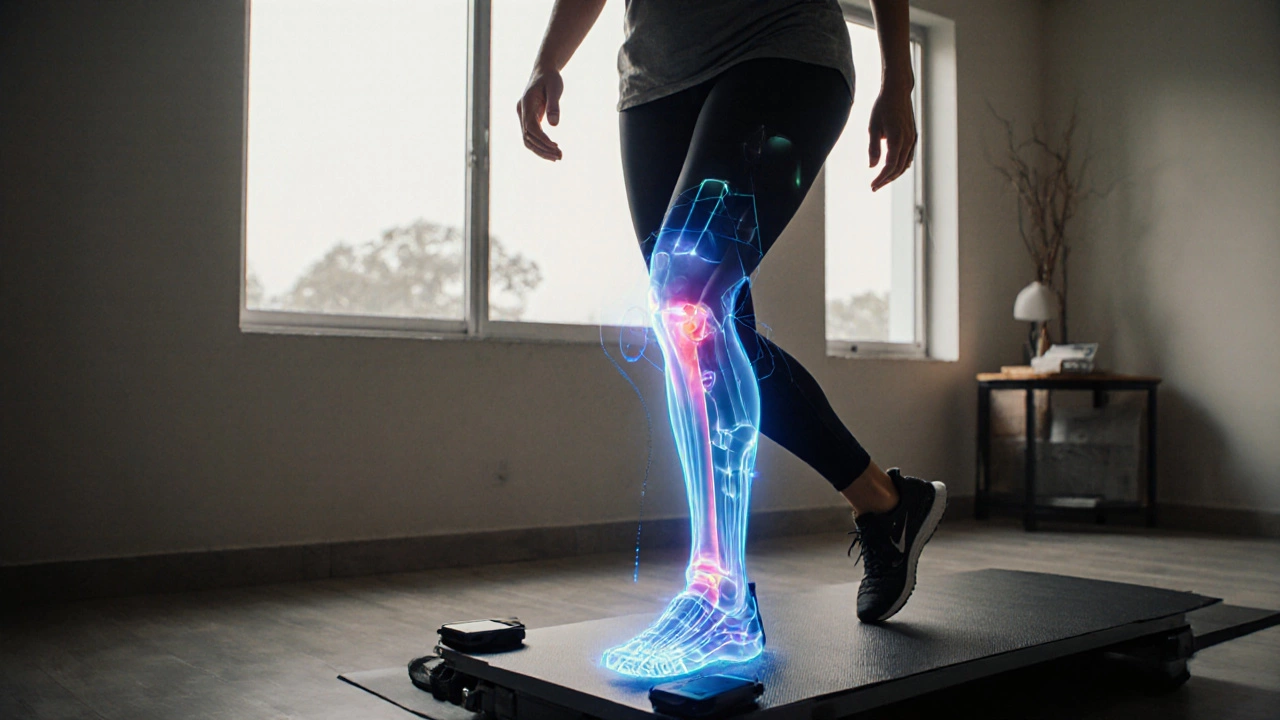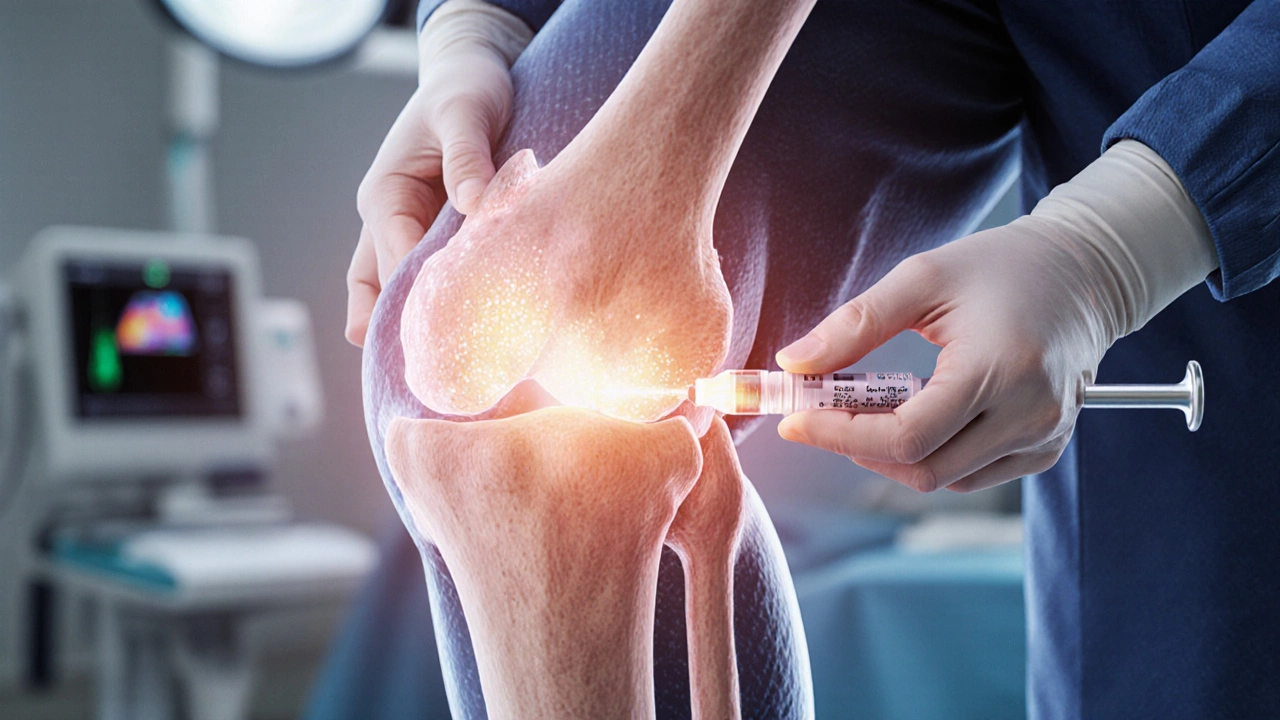Knee Treatment Eligibility Checker
Find the Right Knee Treatment Option for You
Answer a few simple questions to see which non-surgical knee treatment options might be best suited for your condition.
Your Treatment Options
Results will appear here after checking eligibility
For millions of people with chronic knee pain, the idea of knee replacement surgery feels like the only way out. But what if there was another path-one that doesn’t involve cutting out bone, implanting metal, or months of recovery? In 2025, the newest alternatives to knee replacement aren’t just experimental. They’re real, accessible, and backed by growing clinical evidence.
Why People Are Looking Beyond Knee Replacement
Knee replacement works. For many, it’s life-changing. But it’s not perfect. Implants last 15-20 years, and younger patients often face a second surgery later. Recovery takes 3-6 months. There’s a 1-2% risk of infection. And once the natural joint is gone, it’s gone for good.That’s why more people are asking: Can we fix the knee without replacing it? The answer is yes-and the tools to do it have improved dramatically in the last five years.
Regenerative Medicine: Healing Instead of Replacing
The most promising alternative today is regenerative medicine. This isn’t just stem cells in a vial. It’s a targeted, science-backed approach that uses your body’s own healing systems to repair damaged cartilage and reduce inflammation.Two main therapies are leading the charge: autologous chondrocyte implantation (ACI) and bone marrow-derived stem cell injections. ACI takes healthy cartilage cells from a non-weight-bearing part of your knee, grows them in a lab, and reimplants them into the damaged area. It’s been used since the 1990s, but newer techniques now combine it with 3D-printed scaffolds that guide tissue growth exactly where it’s needed.
Stem cell injections, on the other hand, use cells drawn from your own bone marrow or fat tissue. These cells don’t turn into cartilage overnight. Instead, they release signaling molecules that calm inflammation, stimulate repair cells, and improve joint fluid quality. A 2024 study in the Journal of Orthopaedic Research followed 217 patients with moderate to severe osteoarthritis who received ultrasound-guided stem cell injections. After 18 months, 72% reported at least a 50% reduction in pain and improved function-without surgery.
Platelet-Rich Plasma (PRP): The Low-Cost Powerhouse
PRP isn’t new, but its effectiveness has been clarified by recent data. It’s simple: draw your blood, spin it to concentrate the platelets, then inject it into the knee. Platelets carry growth factors that trigger healing.What changed? Now, doctors use leukocyte-poor PRP-a version that removes inflammatory white blood cells. This reduces swelling and makes the treatment more effective for degenerative conditions. A 2023 meta-analysis in Arthroscopy found that leukocyte-poor PRP outperformed saline injections and even corticosteroids for pain relief over 12 months.
Best of all? It’s affordable. In India, a single PRP session costs between ₹8,000 and ₹15,000. Most patients need 1-3 treatments spaced 4-6 weeks apart. No hospital stay. No implants. Just a quick outpatient procedure.

Meniscus and Cartilage Repair: Fixing the Root Cause
Many knee problems start with a torn meniscus or worn cartilage-not full joint failure. That’s why newer arthroscopic techniques focus on repair, not removal.Today’s surgeons use bioengineered scaffolds made from collagen or hyaluronic acid to patch torn meniscus tissue. These scaffolds act like a temporary bridge, letting your body grow new tissue over 6-12 months. One 2025 clinical trial at Apollo Hospitals in Chennai tracked 98 patients with meniscus tears who received scaffold-assisted repair. After two years, 84% avoided knee replacement entirely.
For cartilage damage, the MACI (Matrix-Induced Autologous Chondrocyte Implantation) procedure is now FDA-approved and available in top Indian ortho centers. It’s a two-step process: first, a small biopsy of your cartilage; then, a few months later, a minimally invasive surgery to implant lab-grown cells onto a membrane that fits your joint perfectly.
What About Wearable Tech and Biomechanics?
Sometimes, the problem isn’t just the joint-it’s how you move. Poor alignment, weak quadriceps, or bad walking patterns can accelerate knee wear. That’s where biomechanical correction comes in.Custom orthotics, wearable knee braces with real-time feedback, and AI-powered gait analysis are now part of non-surgical treatment plans. In Pune, clinics like Sujatha Ortho Center use motion-capture systems to map how your knee moves during walking or climbing stairs. Then they design personalized exercises or orthotics to offload pressure from the damaged area.
One patient, a 52-year-old yoga teacher from Baner, avoided surgery after six months of biomechanical rehab. Her knee pain dropped from 8/10 to 2/10. She didn’t need injections or implants-just better movement patterns.
Who Is a Good Candidate for These Alternatives?
These treatments work best for people with:- Mild to moderate osteoarthritis (Kellgren-Lawrence Grade 2 or 3)
- Isolated cartilage or meniscus damage, not full joint collapse
- Good overall health and no major autoimmune conditions
- Willingness to commit to rehab and lifestyle changes
They’re not for everyone. If your bones are rubbing together, your joint is severely misaligned, or you’ve tried everything else, replacement may still be the right choice. But if you’re in the early or middle stages, these alternatives can delay-or even eliminate-the need for surgery.

Cost, Accessibility, and Insurance in India
Here’s how the options stack up in India (2025):| Treatment | Cost per Session (INR) | Sessions Needed | Recovery Time | Insurance Coverage |
|---|---|---|---|---|
| PRP Injection | ₹8,000 - ₹15,000 | 1-3 | 1-2 days | Partial (some policies) |
| Stem Cell Therapy | ₹45,000 - ₹85,000 | 1-2 | 3-7 days | Rare |
| MACI Cartilage Repair | ₹3,50,000 - ₹5,00,000 | 2 (biopsy + implant) | 6-12 weeks | Some corporate plans |
| Meniscus Scaffold Repair | ₹2,80,000 - ₹4,20,000 | 1 | 8-16 weeks | Occasional |
| Knee Replacement (Total) | ₹2,50,000 - ₹5,50,000 | 1 | 3-6 months | Most plans |
Insurance rarely covers regenerative therapies yet. But many clinics offer payment plans. And the long-term savings can be huge-no implant replacement, fewer hospital visits, and faster return to daily life.
The Future Is Already Here
In 2025, the future of knee care isn’t about replacing joints. It’s about repairing them. The newest alternatives aren’t magic. They’re science-carefully tested, increasingly available, and tailored to your body.Yes, knee replacement still has its place. But if you’re facing surgery, don’t accept it as your only option. Ask your orthopedist about regenerative treatments. Get a second opinion. Ask for imaging that shows cartilage thickness-not just X-rays. And give your body a chance to heal before it’s cut open.
Is stem cell therapy for knees FDA-approved?
The FDA has approved specific stem cell procedures like MACI for cartilage repair, but not all stem cell injections. In India, treatments using your own cells (autologous) are legal under guidelines from the Indian Council of Medical Research (ICMR). Always choose clinics that follow ICMR protocols and provide lab reports for cell processing.
How long do the results of stem cell or PRP injections last?
Results vary. Most patients get 12-24 months of pain relief from PRP. Stem cell therapy can last 2-5 years, especially when combined with physical therapy. Unlike implants, these treatments don’t wear out-they help your body repair itself. But if the joint continues to degrade, symptoms may return. Maintenance treatments every 1-2 years are common.
Can I avoid knee replacement if I’m 40 years old?
Yes, and you should try. Younger patients benefit most from regenerative options because their bodies heal better. Replacing a knee at 40 means you’ll likely need another one at 60. Repairing cartilage now can delay surgery by 15-20 years-or eliminate it entirely. Many patients in their 40s and 50s in Pune and Bangalore are choosing this path.
Are there any risks with stem cell or PRP treatments?
The risks are low when done properly. Possible side effects include temporary swelling, bruising, or mild pain at the injection site. The biggest risk comes from unregulated clinics using foreign cells, poor sterilization, or untrained staff. Always ask: Is the cell source my own? Is the lab certified? Is the procedure ultrasound-guided?
What’s the success rate of knee regeneration compared to replacement?
Knee replacement has a 90-95% success rate for pain relief. Regenerative therapies are less predictable but still effective: 60-80% of suitable patients report significant improvement. The goal isn’t perfection-it’s avoiding surgery. If you’re not a candidate for replacement yet, these options give you time and function without the risks of major surgery.
Next Steps: What to Do Now
If you’re considering alternatives to knee replacement:- Get an MRI-not just an X-ray-to see the actual condition of your cartilage and meniscus.
- Consult an orthopedist who specializes in regenerative medicine, not just joint replacement.
- Ask for a detailed treatment plan: which therapy, how many sessions, what rehab is needed.
- Check if your clinic follows ICMR guidelines for cell processing.
- Start physical therapy now. Strengthening your quads and hamstrings can reduce knee stress by up to 40%.
Your knee doesn’t have to be broken to need fixing. And it doesn’t need to be replaced to feel better.





